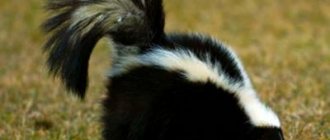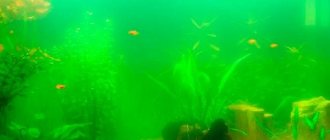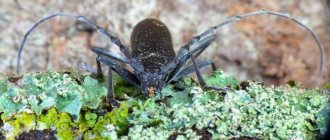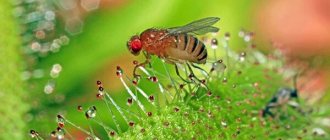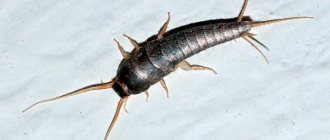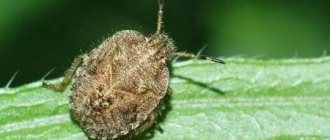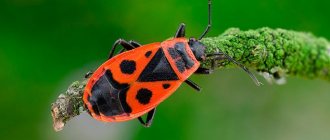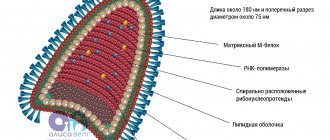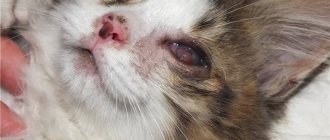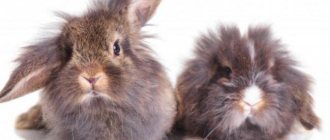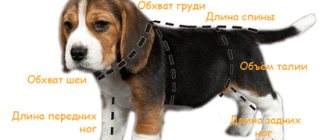Insect pests cause a significant impact on agriculture and forestry. Horntail is one of these representatives. There are 120 species of this insect. Females are usually large. The ovipositor is long and is needed for piercing leaves and further laying eggs there.
Horntails are dangerous pests
The body is cylindrical in shape. The head is rounded. The insect is a pest of coniferous trees. In appearance, the representative resembles a wasp. This is due to the peculiar body color. All subspecies of the insect are active and often settle inside the tree.
Description
The large horntail is a medium-sized insect with a cylindrical body 12-40 mm long. Females are noticeably larger than males. The chest and head of females are black, the abdomen is yellowish with purple-black middle segments. The wings are transparent, brownish with darkening. The ovipositor is long and serrated, resembling a sting. The body color of the male is black, the abdomen is reddish, with black first and last segments. The last segment is finished in a blunt funnel shape. The antennae are long and thread-like. The head is black with 2 yellow spots behind the eyes.
What does an insect look like?
Horntail is a relatively large insect. The female grows only up to 0.7 cm. The male is even smaller. The predominant main color is dark brown. Some body segments have a purple tint. The female has a long and complex ovipositor. The insect has a specific appearance. The female specimen is most easily recognized by its ovipositor. This part of the body stands out and sticks out a lot.
The color of the male is also predominantly black. The belly is reddish in color. The end of the body is funnel-shaped. There are long whiskers on the head, which are divided into 30 segments. The insect larva is white. Three pairs of underdeveloped legs are observed. Eyes are completely absent.
Horntails belong to the order Hymenoptera. Gnawing mouth. The wings are transparent. The legs are powerful and of a running type.
Females and males of horntail have different colors
The eggs are covered with a dense and elastic shell. Females deposit them in tree bark or leaves. This is possible using a pointed shape. Unlike similar wasps and bumblebees, the horntail cannot sting.
The ovipositor of the horntail resembles a kind of drill. Consists of two doors. It is almost impossible to suspect that trees are being damaged by a pest. This is due to the fact that after laying eggs the insect does not leave any traces and the new offspring will be fully formed, increasing the number of parasites.
Nutrition and lifestyle
These insects got their name because both larvae and adults have a spine at the rear end of the body. The first adults of the greater horntail appear in May. Insects are most active in June - July. Life expectancy is about 2 weeks, during which adults do not feed. Mostly these pests settle on diseased or cut down trees. Despite the fact that the jaws of adults are powerful, their bites are painless and safe.
The main damage is caused by horntail larvae. Moreover, the females, along with the eggs that she lays in the bark of spruce, fir and larch, bring into the tree spores of a fungus that destroys the wood to make it suitable for eating by larvae. Despite its harmfulness, the species is listed in the Red Book of individual regions and regions as being under current threat of extinction.
What are the types?
In total there are more than 100 species of horntail. The table describes the main ones.
Read on topic:
Features of the life activity of ladybugs
14.11.2020
Description of chironomids and their possible danger to humans
14.11.2020
What do cutworms look like and what harm do they cause?
14.11.2020
What do goliath beetles look like and can they be bred at home?
14.11.2020
| Greater coniferous horntail | The insect affects all coniferous species. Most often, the insect affects pine and spruce trees. Occasionally, the representative attacks deciduous trees. All contaminated wood will no longer be suitable for construction. The tree itself will soon die and will be able to grow and develop. Adult beetles live only 7 days. The color of the insect is black, and the wings are yellow-brown. One female produces 100-300 eggs. New offspring hatch within a month. |
| Blue pine horntail | The insect attacks young trees, as well as old and weakened ones. All affected flora representatives dry out the next year. The beetle selects only thin-barked plants. The beetle usually attacks trees infected with other parasites. As a result, the plant is completely destroyed and is not suitable for any purpose. The insect flies from June to August. Each female is capable of reproducing up to 500 eggs. The larvae infect wood and make winding passages there. Mushrooms grow on damaged areas. |
All species are classified as pests. You should start fighting insects as early as possible. Otherwise, all trees will be destroyed.
These insects cause great damage to trees in forests
Life cycle
Mating occurs 2-3 days after the imago emerges. After this, the fertilized female begins to lay eggs, drilling a thin channel up to 40 mm deep in the bark and wood, where she usually lays 2-3 eggs. During her short life, a female can lay up to 300 of them. After 3 weeks, the larvae hatch and immediately gnaw inside the tree.
They spend the first winter in the upper, softer layers of wood, which they feed on. In the second year of life, the larva gnaws a passage up and into the trunk. By the beginning of the second wintering, the larva, having reached the last instar of development, moves outward and, approximately 10 mm from the surface of the trunk, gnaws out an oval cradle, where it pupates and overwinters. In the spring, a young insect gnaws a flight hole in a tree to fly out. On average, the development of the larva lasts 2-3 years, but can stretch up to 5-6 years (under unfavorable conditions).
What are the features of lifestyle and reproduction
Insects colonize trees in May. The peak of activity is observed in the summer. First of all, beetles affect diseased plants. A clutch of eggs can usually be found under the bark. After hatching, the larvae will almost immediately make passages and destroy trees. The likelihood of other pests increases.
Affected wood suffers not only from the pest, but also from the fungus that appears in the affected areas. Egg maturation lasts a month.
The larvae first eat the young parts of the trunk, and gradually move closer to the center. Pupation also occurs there. The insect is voracious and eats much more than its weight.
What traces does it leave?
The horntail clogs its passages with waste from its activities. Most often it is drilling meal , and is quite easy to see and identify visually. The larva develops for about three years. An adult insect makes wide round moves and climbs out from the cradle in the center of the trunk. Along with the horntail larvae, other harmful insects also penetrate into the tree, which worsen the condition of the trunk and lead to its death.
The destruction of cockroaches is sometimes unsuccessful if you do it yourself - in this case, you should call a pest control service. Pests of cultivated plants carry diseases such as rot, viruses and bacterial diseases. How to deal with insects that harm indoor plants, read in this article.
On corn you can often find a white butterfly - this is a meadow moth. You can find a full description of this pest at the link.
Greater coniferous horntail (Urocerus gigas L.)
The most common species on conifers are large conifer (Urocerus gigas L.), blue (Sirex juvencus F.), purple (Sirex noctilio F.), black-blue (Sirex ermak Sem.) and black (Xeris spectrum L.) horntails . The largest and most dangerous wood destroyer is the large coniferous horntail (U. gigas L.). There are 4 known subspecies of the large coniferous horntail, differing in the ratio of the length of the ovipositor and the fore wing, the length of the ovipositor valves and its base.
The subspecies Urocerus gigas taiganus Bens is found almost everywhere in the USSR. It is distinguished by its great plasticity and lives in a wide variety of conditions, gravitates to well-warmed, illuminated places, and is found in large numbers in logging sites and upper warehouses where fresh, unbarked wood is available. Females lay eggs in wood in small portions (1-5 pieces) to a depth of 20-25 mm, placing them parallel to the resin passages. After two weeks, larvae appear and make complex passages in the wood (Fig. 23). At first, the move goes obliquely up the trunk, and at a distance of 4-8 cm from the beginning it turns towards the core of the trunk and then returns to the surface. From the middle the stroke has the largest diameter (4-5 mm). Not reaching the surface 1-2 cm, the larva pupates, and the adult horntail emerging from it gnaws a round flight hole (4-5 mm in diameter). The larva overwinters in wood twice, the generation lasts two years.
Rice. 23. Large coniferous horntail: 1 - adult; 2 - larva; 3 - damage
The large coniferous horntail is a very dangerous technical wood pest. This harm is further aggravated by the fact that damage to timber cannot be detected until flight holes appear. Therefore, in new buildings, large drill bits (wormholes) often appear in the floor and ceiling boards, and then round holes. This is usually very scary for home owners because they are afraid that fresh infestations will occur and the wood will be completely destroyed.
The horntail gnaws its way out with great force. There are many indications in the literature that it gnawed through the iron cladding of wooden objects, lead chambers, gas pipelines, and various metal objects lying on wood infested by it. There are also indications that horntail larvae spread spores of wood-decaying fungi, which decompose fiber and lignin, quickly reducing the strength of wood. Their significance for horntails apparently lies in the fact that they prepare the wood for feeding the larvae and reduce the stability of the tree.
Appearance of horntails
These beetles have a long, cylindrical body. The back of the body is pointed. Females have a clearly visible, long ovipositor.
Horntail larva.
The larvae are cylindrical in shape, slightly curved in the shape of the letter S. The color is whitish. The larvae have 3 pairs of vestigial thoracic legs. On the back of the abdomen there is a stepwise process.
What the affected areas of wood look like
The insect eats branched passages in the wood. The parasite clogs all the tunnels with the products of its vital activity. Additionally, fungal spores germinate there. It is quite difficult to recognize an infected tree externally. Damage can only be determined by cutting the wood.
It is not noticeable which trees contain a clutch of eggs. After laying new offspring, there are no external signs on the bark. This makes pest control difficult. It is quite difficult to remove the parasite from the site.
You will find out why the large coniferous horntail is dangerous. after watching this video:
The tree dies not only because the horntail appears. A damaged plant weakens and becomes susceptible to other diseases and pests.
Economic importance
Horntails are secondary and technical pests of coniferous wood: spruce, pine and fir. They can also be pests of technical structures or furniture. It is very difficult to recognize damage even when sawing. Damage to large timber can be detected only after flight holes appear on the surface. Horntails do not sting and have no poison.
Tremex columba
Horntails have been known since the early Jurassic period. The family includes about 120 species in 20 genera.
Taxonomy of the family True horntails (Siricidae):
- Subfamily: Siricinae = Genus: Sirex =
- Genus: Sirotremex =
- Genus: Urocerus =
- Genus: Xoanon =
- Genus: Afrotremex =
Fighting methods
Since the horntail grows not only in forest plantations, it can be dangerous for coniferous timber warehouses and residential buildings built from it. Infestation of the trees themselves is no less dangerous: the large horntail is capable of destroying a large area of forest, including rare conifers, and at the first sign of its appearance, measures must be taken.
The favorite delicacy of the large coniferous horntail is felled forest, so wooden houses must be treated with special compounds against insects and fungus.
Such compositions are applied with a brush or roller, and can be purchased at any hardware store. A simple spraying with Actellik can help save your garden from horntail. It should be diluted in the following proportion: 20 grams per 10 liters of water. This is the same substance
will help get rid of other wood-eating pests.
In addition to chemicals, other insects can also get rid of the horntail population. For example, ground beetles, pests, predatory bugs or rove beetles can greatly reduce the number of parasites. You can also use the introduction of insects from the ichneumonid family, and they will parasitize the egg clutches and destroy the horntail larvae before they are born.
Finally, in nature, the large coniferous horntail becomes prey for all kinds of woodpeckers, and favorable conditions should be created for these birds to destroy the horntail in a designated forest area. This method is best for protecting trees in their natural environment.
